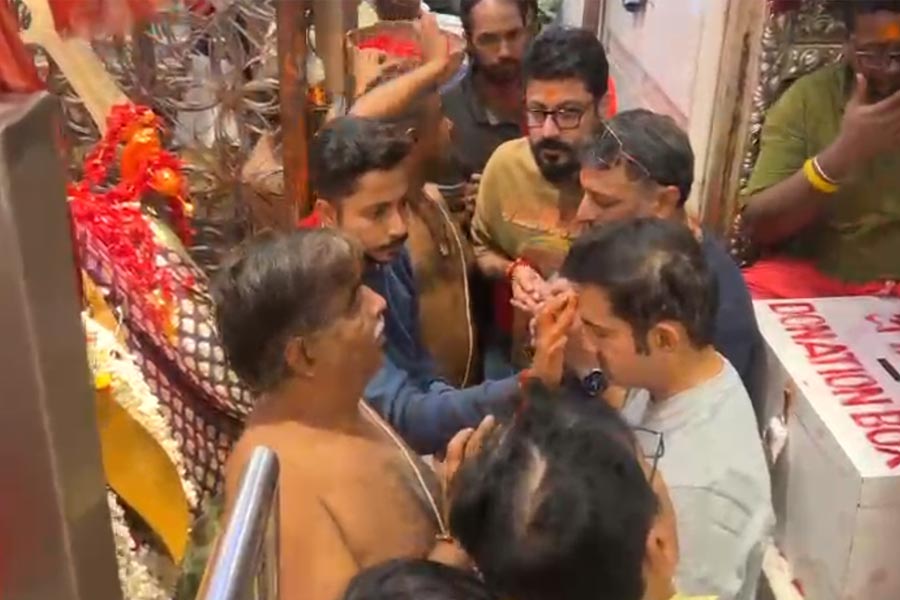Forgotten delicacy
Sir — In the age of social media, a Bengali living in Calcutta knows more about sarson da saag than she does about aloo koraishuti diye shorshe shaak bhaja. While there is no denying that the Punjabi delicacy is a must try in winter, the humble Bengali shaak makes for an equally delicious meal with some piping hot rice and ghee, perhaps even with a dash of fried boris crushed on top. Yet, people are thronging to the dhabas in the city and waiting in queues to taste the former while the latter cooked in the hygienic home kitchen lies in great disregard. ‘Satya Seleucus, ki bichitra ei desh.’
Manash Pal, Calcutta
Spectral realm
Sir — The ‘capitalist presence’ extends beyond the ‘ghostly past’. Intrigued by Uddalak Mukherjee’s article, “Spirits of resistance” (Nov 28), I went to Amazon — the domain of the ace capitalist, Jeff Bezos — to buy Tithi Bhattacharya’s book only to be spooked away by its price. I wonder whether Bhattacharya writes about the fact that while the interest in the ‘bhadralok bhoot’ was a result of 19th-century scholarship, these bhoot-petnis were brought into the lives of Bengalis and Englismen alike by the subaltern dasis — both Rabindranath and Abanindranath Tagore, for instance, have written of dasis telling them spooky tales of Brahmadaityas. It would have been interesting if Mukherjee made space for the subaltern in his column.
Mrinal Kanti Kundu, Howrah
Sir — The leading lights of Bengali literature have written ghost stories. While some ghosts are indeed scary or revengeful, most of them were timid, humorous and cooperative with tragic histories that brought a lump to the throat.
However, not all ghosts in Bengali literature are actually spectres. There is a story about a boy who visits his maternal uncle’s farmhouse after hearing that the latter is trading in ghosts. The uncle shows him ‘ghosts’ who look all too human and can garden and even cook. A couple from the West even adopt a ghost. Later, the uncle confides that these were actually not ghosts but poor, marginalised outcasts who have been abandoned by society and thus rendered spectral. The uncle thus comes up with this novel business plan to help them. These so-called ghosts can be dubbed as
“[s]pirits of resistance” just like the ones Uddalak Mukherjee mentions.
In fact, as the author, Stephen King, once wrote, “... ghosts are real too. They live inside us...”. Our past selves that live within us are kind of ghosts too.
Kajal Chatterjee, Calcutta
Sir — “The bhadralok bhoot, even in retreat, signify a spirit of feisty resistance,” argues Uddalak Mukherjee. But such a resistance does not extend to the caste system. Brahmadaityas reside in the tallest of trees, maintaining their social superiority over other spectres even after death. Female ghosts are said to inhabit shorter bushes and shrubs. Their respective habitats illustrate not only the Brahmadaitya’s primacy
on the spectral social ladder but also the gender norms permeating into the ‘other’ realm from the human world.
Puranjit Sanyal, Nadia
Sir — Uddalak Mukherjee manages to pull yet another rabbit — or should we say Brahmadaitya? — out of his hat in “Spirits of resistance”. Indigenous things are all the rage these days. But our indigenous ghosts still seem to be out in the cold with old, ghost-friendly mansions turning into boxy apartment buildings with 24-hour security cameras. Trees have been chopped and marshlands filled and the ghostly glow of the Aaleyas and Peys cannot compete with the blazing electric lights all around them. The hapless ghosts of India have nowhere to go, not even to a Halloween party populated by Draculas, Frankensteins and Jokers.
Yashodhara Sen, Calcutta
Sir — These days, there is exceptional enthusiasm for Halloween. This has eclipsed the wondrous, humane and gentler ghost stories in Bengali literature and culture. This worries Uddalak Mukherjee, who tries to find reasons for this retreat in his article. His exploration of the cultural fascination with these benign ghosts and the values that these almost-forgotten spirits embodied are interesting.
Sukhendu Bhattacharjee, Hooghly
Look for a cure
Sir — A fifth of all deaths caused by anti-microbial resistance occurs in India. Despite this, India may also be the heart of the solution to this problem. Given its strong pharmaceutical sector, India has everything it needs to not only reverse the crisis within its own borders but also lead the way in the global AMR response.
Arun Gupta, Calcutta
Unfiltered
Sir — Earlier this year, parents in the United States of America had launched a petition against TikTok and YouTube for promoting body dysmorphia among children. Now, TikTok has announced restrictions on the use of beauty filters by users below the age of 18. This is a welcome move, even if its effectiveness is reliant on people being truthful about their age on social-media platforms.
Kalyan Ghosh, Calcutta











